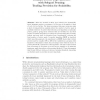Free Online Productivity Tools
i2Speak
i2Symbol
i2OCR
iTex2Img
iWeb2Print
iWeb2Shot
i2Type
iPdf2Split
iPdf2Merge
i2Bopomofo
i2Arabic
i2Style
i2Image
i2PDF
iLatex2Rtf
Sci2ools
ECOOP
2004
Springer
2004
Springer
Demand-Driven Type Inference with Subgoal Pruning: Trading Precision for Scalability
After two decades of effort, type inference for dynamically typed languages scales to programs of a few tens of thousands of lines of code, but no further. For larger programs, this paper proposes using a kind of demand-driven analysis where the number of active goals is carefully restricted. To achieve this restriction, the algorithm occasionally prunes goals by giving them solutions that are trivially true and thus require no further subgoals to be solved; the previous subgoals of a newly pruned goal may often be discarded from consideration, reducing the total number of active goals. A specific algorithm DDP is described which uses this approach. An experiment on DDP shows that it infers precise types for roughly 30% to 45% of the variables in a program with hundreds of thousands of lines; the percentage varies with the choice of pruning threshold, a parameter of the algorithm. The time required varies from an average of one-tenth of one second per variable to an unknown maximum, ...
| Added | 01 Jul 2010 |
| Updated | 01 Jul 2010 |
| Type | Conference |
| Year | 2004 |
| Where | ECOOP |
| Authors | S. Alexander Spoon, Olin Shivers |
Comments (0)

